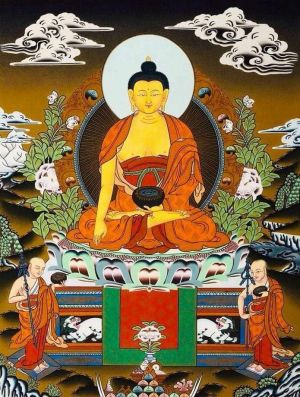Difference between revisions of "Four Paths"
(Created page with " The Four Paths or Stages on the Path to liberation are (I) Sotāpanna: ‘He who has entered the Stream’. At this stage he is free from the first three of...") |
|||
| (One intermediate revision by the same user not shown) | |||
| Line 1: | Line 1: | ||
| + | [[File:722.jpg|thumb]] | ||
| + | [[The Four Paths]] or Stages on the [[Path to liberation]] are | ||
| + | |||
| + | |||
| + | (I) [[Sotāpanna]]: ‘He who has entered the Stream’. At this stage he is free from the first three of the [[Ten Fetters]] ([[Sam yojanas]]), i.e. | ||
| + | |||
| + | [[Sakkāya-ditthi]]; the [[illusion]] of being a ‘[[self]]’ separate from all other selves. | ||
| + | |||
| + | (2) [[Vicikicchā]]; [[mental]] vacillation, [[doubt]]. | ||
| + | |||
| + | (3) [[Sīlabbata-parāmāsa]]; [[belief]] in the efficacy of [[Rites and Ceremonies]]. | ||
| − | [[ | + | The second stage is (II) [[Sakadāgāmin]]: ‘He who will return once only’ to this [[world]] before [[attaining]] [[liberation]]. |
| − | |||
| − | + | Such is nearly free from | |
| − | + | (4) [[Kāmacchanda]], [[delusions]] of the [[senses]]. | |
(5) [[Patigha]] or [[Vyāpāda]]; [[ill-will]] or [[aversion]]. | (5) [[Patigha]] or [[Vyāpāda]]; [[ill-will]] or [[aversion]]. | ||
| Line 15: | Line 25: | ||
(III) [[Anāgāmin]]: ‘He who will never return’ to this [[world]]. being utterly free from these five [[Fetters]]. | (III) [[Anāgāmin]]: ‘He who will never return’ to this [[world]]. being utterly free from these five [[Fetters]]. | ||
| − | (IV) [[Arahat]]: ‘The Worthy | + | (IV) [[Arahat]]: ‘The [[Worthy One]]’, who attains [[Nirvāna]]. |
| + | |||
| + | Such a one has cast off the five higher [[Fetters]] of (6) [[Rūparāga]], [[desire for existence]] in the [[worlds]] of [[form]]; | ||
(7) [[Arūparāga]], [[desire for existence]] in the [[formless worlds]]; (8) [[Māna]], [[Conceit]] | (7) [[Arūparāga]], [[desire for existence]] in the [[formless worlds]]; (8) [[Māna]], [[Conceit]] | ||
| + | |||
| + | |||
| + | {{R}} | ||
| + | [[Category:Buddhist Terms]] | ||
Latest revision as of 06:34, 13 December 2020
The Four Paths or Stages on the Path to liberation are
(I) Sotāpanna: ‘He who has entered the Stream’. At this stage he is free from the first three of the Ten Fetters (Sam yojanas), i.e.
Sakkāya-ditthi; the illusion of being a ‘self’ separate from all other selves.
(2) Vicikicchā; mental vacillation, doubt.
(3) Sīlabbata-parāmāsa; belief in the efficacy of Rites and Ceremonies.
The second stage is (II) Sakadāgāmin: ‘He who will return once only’ to this world before attaining liberation.
Such is nearly free from
(4) Kāmacchanda, delusions of the senses.
(5) Patigha or Vyāpāda; ill-will or aversion.
(III) Anāgāmin: ‘He who will never return’ to this world. being utterly free from these five Fetters.
(IV) Arahat: ‘The Worthy One’, who attains Nirvāna.
Such a one has cast off the five higher Fetters of (6) Rūparāga, desire for existence in the worlds of form;
(7) Arūparāga, desire for existence in the formless worlds; (8) Māna, Conceit
